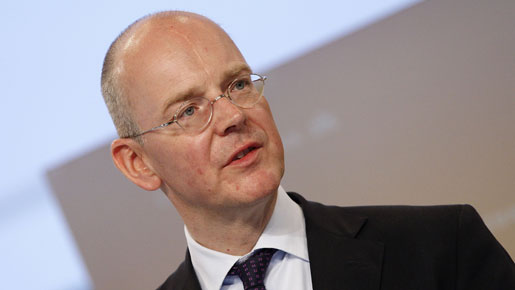
Martin Blessing’s appointment to CEO of Commerzbank in May 2008 was viewed by many as kismet. Blessing comes from a family whose history is steeped in banking tradition. His grandfather Karl was president of the Bundesbank between 1958 and 1969, and his father, Werner, was a board member at Deutsche Bank.
Blessing’s own background largely lies outside the banking industry, but that hasn’t stopped him from landing the top job at Commerzbank. He studied Business Administration at the University of Frankfurt and the University of St. Gallen in 1987 before receiving an MBA from University of Chicago in 1988. He completed his apprenticeship at Dresdner Bank from 1983 to 1984, then forged a successful career at US consultancy firm McKinsey.
During his studies he met his current wife, Dorothy Wieandt, daughter of the former CEO of the Bank of Collectivism, Paul Wieandt. The company is now a partner at investment bank Goldman Sachs. The couple has three daughters and his brother-in law, Alex Wieandt is CEO of Hypo Real Estate, the completely nationalised bank which ran into trouble during the epicentre of the financial crisis in October 2008.
Following many years providing management consultancy advice to the banking industry, Blessing made the move to the banking industry, joining Dresdner in 1997 as deputy head of retail banking. Just three years later he was named CEO of Advance Bank, Dresdner’s now defunct online banking service. He has been a member of Commerzbank’s Board of Managing Directors since 2001.
Blessing was recruited to the board by then CEO Klaus-Peter Müller, who was intent on breaking up the incumbent ‘old boy network’ within the bank. Blessing’s first task was to turn around the bank’s beleaguered retail banking business, an area that underwent significant reorganisation and restructuring under Blessing’s stewardship.
Acquisition of Dresdner
The biggest structural change that Blessing has implemented in his short time as CEO – and one that has posed him the biggest challenge – is Commerzbank’s takeover of rival banking institution, Dresdner. In August 2008, Commerzbank announced that it is to purchase 100 percent of Dresdner Bank for €10bn, largely using share capital.
When the integration is complete, the combined group will have some 11 million customers, 1,200 branches and 10,000 employees, with Blessing promising that the group will be ‘closer to our customers than any other German bank’. Overall, the aim is for the group to be the number one German bank in terms of SME business, and the biggest export financer for German industry. Such bold statements of intent are reflected in the new motto: “Achieving More Together.”
Commenting on the merger, Blessing announced the group’s intention to be Germany’s ‘number one bank for private and corporate customers’, but also acknowledged achieving this would not be easy.
“With the merger in May 2009 and the successfully proceeding integration, and our sustained success in customer business, we are a clear step further to achieving our goal of becoming the number one bank in Germany for private and corporate customers,” he says. “Naturally this will be no Sunday afternoon stroll – more like a challenging walk in the mountains. But we are equipped to cope successfully with the path that lies before us.”
Redundancies
One of the major hills Blessing encountered during his challenging mountain walk was the need to implement a post-takeover redundancy programme – one of the biggest in recent banking history, eclipsing even the 900 jobs shed at UBS in London. At the time Commerzbank employed some 1,000 people in London, while the Dresdner Kleinwort operation had approximately about 2,000, so redundancies were inevitable.
Other areas of concern for Blessing were the underperformance of certain divisions of the bank. To address these issues, in 2009 he announced that Commerzbank would be pulling back from key areas such as proprietary trading, UK equities and mergers and acquisitions. Blessing confirmed that he was open to offers for the unwanted parts of the business, although he admitted that he was sceptical that there were serious buyers in a market so recently ravaged by financial turmoil.
Surviving the crisis
Under Blessing, Commerzbank managed to withstand the full force of the banking crisis. Perhaps due to its robust business model, strengthened by Blessing’s restructuring some years earlier, Commerzbank emerged from the crisis stronger than many of its rivals.
Whereas – along with every other German bank – it did receive some state aid, in late 2009 it announced that it would not need to use a large proportion of the government’s guarantees and did not need to issue any more state-backed bonds. One result of this is that the post-acquisition integration has been rolled out much quicker than expected, with some branches receiving the new Commerzbank brand presence from the second quarter of 2010, rather than from the end of the year.
On the whole, Blessing has lived up to expectations so far. The acquisition of Dresdner was a bold move and will have endeared him to the bank’s management committee, but the enduring job losses are unlikely to have impressed the government or the general public.
However, his clear statement of intent to establish Commerzbank as the number one banking institution in Germany, is unparalleled in a world emerging from a catastrophic banking crisis. Having followed in his forefathers’ footsteps, Blessing is now widely tipped to succeed Klaus-Peter Müller as chairman of the supervisory board, who is now at pensionable age.
On Commerzbank’s future, Blessing sums it up perfectly. “We are well on the way to making the new Commerzbank what it should be – the best bank in Germany. The crisis has shown clearly that a stable business model is absolutely essential, and this is something we have in our retail and corporate business as well as our Central and Eastern European business.”

